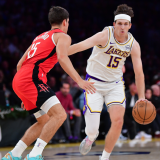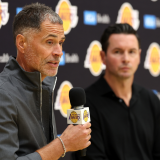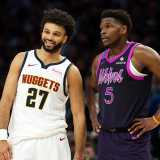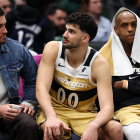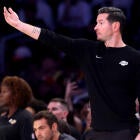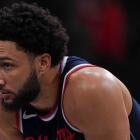The InBounds: San Antonio and the irreplacable model
The San Antonio Spurs' model can't be copied. Here's why.
 |
| The model franchise? (Getty Images) |
The NBA is well known to be a copycat league. Everyone's working with the same materials: athletic and/or skilled human beings bouncing and throwing a ball in an attempt to successfully send it on a downward trajectory through a cylinder attached to a fibeglass backboard with a downward hanging net. So with a finite number of resources and/or variables, you're going to see certain formulas come into play, and when one formula works, you'll find any number of other entities trying to apply that formula in the hopes of the same success.
This, to be honest, is a pretty terrible approach, all things considered.
We're all snowflakes, after all, in this fuzzy little world. Each of us is different and one big man is different from another big man even if they can both hit a hook or bank shot. One devastatingly nimble point guard is not the same as the next, and so forth. Coaches aren't the same, personalities in the locker room aren't the same, skillsets, no matter how similar, are not the same. Basketball, like anything in this world, is subject to chaos theory, and trying to land close enough inside the target is way harder than this:
And yet it happens.
The superstar triumverate model is the latest craze. Melo-Stoudemire-Chandler, CP3-Blake-Jordan/Crawford/Billups, Deron-Johnson-Lopez, Lin-Harden-Asik, Rose-Boozer-Noah/Deng and of course LeBron-Wade-Bosh are all derivitive of Boston's model it started with Pierce-Garnett-Allen (which later became Pierce-Garnett-Rondo). The Lakers tried taking it a step further to the quadstar, with Kobe-Nash-Gasol-Howard, but, as you know, that's still a work in progress with poor early returns.
So then, here's an interesting question.
Did the Celtics or any of these other teams try to emulate the San Antonio Spurs, and if not, why not?
--------------------------
The key with talking about San Antonio's phenomenal 13-years-and-going-strong run is to recognize that if you talk to 10 people with any knowledge, you're going to get four-to-five answers as to how to define that model. Answers include but are not limited to:
-- Draft a Hall of Fame player and then surround him with skill-proficient supporting substars, then build around that with capable role players willing to sacrifice.
-- Surround the Hall of Fame player with two more elite-to-near-elite stars by managing to turn what is normally a crapshoot, the NBA Draft, into your own private video game in which you alone have the cheat code to discover how awesome the two players are. Implement good system. Succeed.
-- Draft Hall of Fame player, then use his dominance to allow opportunities for skill-centric (versus athleticism-centric, though Parker and Ginobili are of course very athletic) players to thrive, then focus on spot-up shooters with good defensive acumen.
-- Draft a Hall of Fame player, then draft another Hall of Fame player, then draft another Hall of Fame player. Make them play defense and surround them with character guys who won't get in the way.
You'll notice the central theme there, involving drafting the Hall of Fame player, which is something that of the serious contenders in the NBA, only the Heat, Celtics, and Lakers have had that fortune (Clippers pending). But the other two have come from free agency or trade.
But there is some debate as to whether you attribute more to the contributions of Parker and Ginobili or the overall roster makeup, which has made a stars out of Michael Finley far past his prime, Robert Horry far past his prime, Bruce Bowen when he would be marginal anywhere else, and Matt Bonner when he would have no role anywhere else. You have to account for both, especially as Parker has emerged as the primary offensive creator since 2007, and Ginobili has from time to time been labeled their most important player. Each season, one of the Big 3 plays better than we expect them to. Two years ago it was Manu Ginobili, last season it was Tony Parker, this year it is Tim Duncan.
The symbiotic system between the three primary components and the rest of the team is vital for consideration of the model, though. The role players space the floor, play defense, and make big shots, which opens up opportunities for the stars, and the stars' brilliance creates opportunities for those role-players to make those shots and to save their energy for the defensive end.
Tie it in a bow with a meticulous and well-constructed playbook framework that allows for both the execution of primary options and creative freelancing by the stars (if Duncan senses a mismatch, he goes to it, if Parker wants to take his man, he can, if Ginobili finds his opponent giving too much space, he's free to launch the three), and you've got some semblance of what makes the Spurs so successful. That success surges and wanes depending on their defense. (Popovich has openly admitted as the roster has evolved he's had to focus more on offense, and you can see the drain that has produced on their postseason performance -- in 2011 their defense was flat out mediocre and it cost them against Memphis, in 2012 it wasn't quite good enough and was exposed vs. the Thunder, and in 2013 they're on pace to return to elite stature. Just a heads up, you don't want to screw with this Spurs team.)
So that sounds easy enough, right?
OK, it doesn't sound easy at all, and that's why so few teams have replicated it. The Spurs are the most common answer to two challenges of the NBA system, 1.) that the draft is essentially a crapshoot and you can't really predict at even an 80 percent level that a player will live up to expectations, and that 2.) the Spurs are proof that there is no hindrance to operating in a small-market if you're smart enough.
Basically, it comes down to this. The Spurs have been smarter than everyone else, and that intelligence has yielded the necessary supporting characters for Tim Duncan that eveyone else has to go out and buy through free agency or trade. They're just better, and that's the explanation for their longstanding success; the same intelligence that yielded them Ginobili and Parker (and Hill and Leonard and...) is the same intelligence that helps them build with the right role players within the right system. Parker was drafted 28th, Ginobili 57th. You can find role-player veterans who can hit 3s and rebound, can find capable nondescript contributors to fit the system. But finding two vital cogs and spectacular players to go alongside your icon, late in the draft?
You just can't do that.
How do you do that?
How do you draft, at minimum, two Hall of Fame players, one in the high 20s, the other in the second round?
And that's the struggle. That's why you can't replicate what they've done. But there's another reason this combination is so special. And it has a lot to do with the conspicuous absence of a major team in the comparison spectrum.
-----------------------------
The easiest comparison to the Spurs is the Thunder. Sam Presti is a Spurs disciple, one of many who now manage or coach in the league right now. They drafted said Hall of Famer. (Am I jumping ahead with Kevin Durant? No. I'm not. He's headed there. Deal with it.) Then they drafted Russell Westbrook and James Harden. They didn't draft them in the high 20s, but they made sure to get those picks and use them correctly when Durant was still a pup.
(We can throw Serge Ibaka into this model as more proof, but he's kind of a combination of Robert Horry, Fabricio Oberto and Finley from the Spurs' glory years. He hits big shots, he makes big defensive plays, he pisses everyone off and he cleans up the glass.)
And yet Ginobili and Parker are still jogging up the floor with Duncan (resting whenever he feels like it), and Harden is making an All-Star push in Houston. Why is that?
This is tricky territory we're about to get into, but it's vital for signaling why the Spurs' success was so unique and beyond replication. The Thunder did everything you want to do to set up the kind of sustained success the Spurs have had, and are hurtling toward their fourth year of playoff contention. They have the Hall of Fame, once-in-a-lifetime player, the devastating point guard. They had the spectacular, crafty, smooth Euro-stepping wing. What happened?
Ginobili and Parker were willing to sacrifice, Westbrook and Harden were not.
Stop right there.
This is not a value judgment on Westbrook or Harden. Your average NBA star gets at most four contract negotiations. You have four opportunities to determine your total career earnings. You're young, but you have to look out for the greater part of your entire life earnings through these four opportunities. You come from hard conditions, you've worked your face off to be some of the best players in the business, you want the income and respect that comes with that payday. You cannot, should not blame them for wanting what they got. But the result is the same, and the rules are different now than they were when the Spurs' danced with the stars. The Thunder couldn't afford to keep Harden, so they got return on him.
And the Thunder are possibly better. Whether Durant and Westbrook have taken the leaps they have this season as a part of their natural, inevitable progression or because Harden's departure has demanded it of them is immaterial. Harden is gone, the Thunder keep winning. Everything goes on.
But it does stand as yet another challenge to the idea you can "copy" the Spurs. If Ginobili and Parker had both demanded max contracts, the Spurs would have set them free. That might be the most amazing thing about the Spurs' run from a management standpoint. They don't get hustled on contract extensions. Ever. They get their guys back at the price they want, because in a rare switcheroo in the NBA's constant salivating pool that shimmers beneath free agents, players want to play for San Antonio. The Thunder haven't gotten to that point, and have players who might honestly have more upside. We'll never know how Parker or Ginobili would have fared in different places in their primes like we're seeing Harden in Houston.
Instead, Ginobili came back for $52 million over six years in 2004, Paker for six-years, $66 million. I'm not going to single out any of the contracts handed out this summer but safe to say, those guys got market value, the Spurs got their guys back at basement deals. And if you say that's because Ginobili and Parker hadn't hit their primes, that's fine, San Antonio got them back for discounts the last two years the same.
-------------------------------
It takes too much for a team to replicate the Spurs.
You have to not only land the Hall of Famer, you have to land him, have him stay healthy, and have him be the kind of guy who goes "Tracy McGrady? Grant Hill? Nah, I'm good here" and who never screws with chemistry. Then you have to land discount superstars who are consistently underrated and are willing to re-sign for less just to keep the team together, have veterans who want to be a part of your team and always deliver while staying marginally healthy and have garbage-time players play vital roles (Oberto, Tiago Splitter, and others have played huge roles for this team).
Oh, and you need a coach who manages to command their love and respect while still screaming at them about blown rotations on national television and who implements the perfect system to control the game.
So no, it's not possible to replicate that. But maybe teams are too easy to give up on that dream. Maybe establishing the kind of culture San Antonio has, which promotes players re-signing under market value, which drafts well in late rounds, which turns unstable territories into advantages, is what they should do. Because as it stands, most of this star accumulation isn't actually paying off the way teams dream. They're winning, but not at championship levels, and they're getting headlines but often for the wrong reasons.
And San Antonio? Their only headlines are when they have success.


